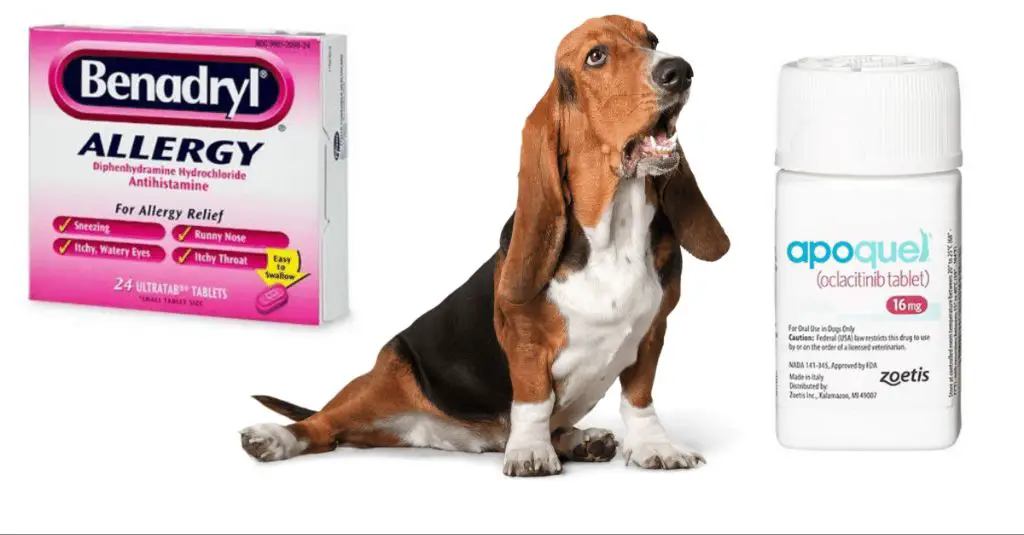Introduction
Hives, also known as urticaria, are itchy, swollen welts on a dog’s skin that can appear very suddenly. They are caused by the release of histamine in the skin in response to an allergen or other triggers. Hives can occur anywhere on a dog’s body and can range in size from a few millimeters to several centimeters across.
Benadryl (diphenhydramine) is a common over-the-counter medication used to treat hives in dogs. It blocks the release of histamine, providing relief from the symptoms. However, Benadryl does not work for all dogs and hives may persist or return despite treatment with Benadryl.
Types of Dog Hives

There are a few different types of hives that can affect dogs:
Acute Hives
Acute hives, also known as acute urticaria, come on suddenly and may last for up to 6 weeks. They appear as raised, round, red welts on the skin that are very itchy. Acute hives are often caused by an allergic reaction to foods, medications, insect bites, or other environmental triggers.
Chronic Hives
Chronic hives, also known as chronic urticaria, are hives that recur over longer periods of time, often many months or years. The welts come and go randomly with no clear cause. It’s believed immune system dysfunction may play a role. Chronic hives can be frustrating to treat.
Idiopathic Hives
Idiopathic hives have no known cause. They may occur as acute or chronic hives with no identifiable trigger. The term idiopathic simply means the cause is unknown. Identifying potential triggers and trying elimination diets is recommended to determine the source, if possible.
Common Causes
There are several common causes of hives in dogs:
Allergies
Allergies are one of the most frequent triggers of hives in dogs. Like humans, dogs can develop allergic reactions to foods, medications, vaccines, plants, or chemicals. These allergens cause the immune system to release histamine, which leads to itching and hives.
Insect Bites/Stings
Insect bites or stings often result in hives on dogs. The venom or saliva entering the body triggers the immune system to release histamine. Bee stings, ant bites, flea bites, and fly bites are common culprits.
Infections
Bacterial, viral, fungal, and parasitic infections can cause hives in dogs. The infection triggers the immune system to activate and release histamine. Skin infections are a common cause.
Autoimmune Disorders
Sometimes a dog’s immune system mistakenly identifies normal cells or proteins as a threat and attacks them. This immune response releases histamine and causes hives. Autoimmune diseases like lupus can lead to chronic hives in dogs.
Diagnosing the Cause

Figuring out what is causing your dog’s hives is important for finding the right treatment. There are a few ways your vet can help diagnose the cause:
Veterinary Exam
Your vet will do a complete physical exam, looking closely at your dog’s skin for signs of hives, rashes, or skin irritation. They will note the location, size, and appearance of any skin lesions. Your vet may also take a skin scraping or hair sample to check for parasites.
Allergy Testing
Blood or skin allergy tests can help identify environmental, food, or other allergies that could be causing hives. Blood tests measure antibodies, while skin tests look for a reaction after exposing your dog to potential allergens.
Eliminate Suspected Causes
Your vet may recommend removing suspected triggers from your dog’s environment, like certain foods, dust, or chemicals. Avoiding the potential cause for 2-3 weeks can help determine if it’s responsible for the hives.
When Benadryl Doesn’t Work
Benadryl (diphenhydramine) is often the first line of defense for treating dog hives. However, there are some instances where Benadryl may not be effective:
Severe Reaction
If your dog is having a severe allergic reaction with extensive hives, facial swelling, or difficulty breathing, Benadryl may not be potent enough. You’ll need to take your dog to the emergency vet right away for more aggressive treatment like steroids or epinephrine.
Chronic Hives
For dogs with chronic idiopathic urticaria (hives with an unknown cause) that last more than 6 weeks, Benadryl probably won’t resolve the underlying condition. Your vet may need to do testing and trials of other medications to control the hives.
Wrong Dosage
It’s crucial to give the proper Benadryl dosage based on your dog’s weight. Too little won’t have an effect. Too much can potentially cause side effects like sedation. Consult your vet on the correct dose if you’re unsure.
Other OTC Options
If Benadryl does not provide relief for your dog’s hives, there are a few other over-the-counter medications you can try:

Antihistamines: Other OTC antihistamines like Claritin (loratadine) or Zyrtec (cetirizine) can provide relief from itchiness and hives in dogs. The dosage will depend on your dog’s weight. Check with your vet on the appropriate dosage. These medications work the same way as Benadryl, blocking histamine receptors to reduce inflammation. They may cause drowsiness.
Hydrocortisone cream: Applying a topical hydrocortisone cream to the affected areas can help reduce inflammation and itching. Use a cream formulated for dogs and avoid prolonged use, as steroids can have side effects. Only apply to superficial skin areas and not open wounds.
Be patient, as it may take some trial and error to find the right OTC medication or combination of medications to provide relief for your dog. Follow dosage directions carefully and monitor for side effects like increased thirst, drowsiness or gastrointestinal upset. See your vet if OTC options are not helping within a few days.
Prescription Medications
If over-the-counter medications like Benadryl don’t help relieve your dog’s hives, your veterinarian may prescribe stronger medications. Some common prescription options for dog hives include:
Steroids
Steroids like prednisone or dexamethasone help reduce inflammation and itching associated with hives. They work by suppressing the immune system reaction causing the hives. Steroids come in oral and injectable forms. Side effects may include increased thirst, urination, and appetite.
Cyclosporine
Cyclosporine modifies the immune system response to prevent hives. It’s commonly used for chronic hives lasting over 6 weeks. Cyclosporine requires routine blood testing to monitor drug levels and kidney function.
Oclacitinib
Oclacitinib (brand name Apoquel) is a newer oral medication that blocks the itch-inducing pathways involved in hives. It provides rapid relief within 24 hours. Side effects are generally mild but may include vomiting, diarrhea, or skin infections.
Consult your vet to see if prescription antihistamines or immunosuppressants may help control your dog’s hives when OTC medications fail. But always follow up to determine the underlying cause.
Home Remedies
There are several at-home remedies that can help soothe dog hives when Benadryl is not working effectively. Two of the most popular home remedies are oatmeal baths and cold compresses.

An oatmeal bath can help relieve itchy skin caused by hives. Make a paste using colloidal (finely ground) oatmeal and lukewarm water. Apply the paste directly to the dog’s skin and let sit for 5-10 minutes before rinsing off. The oatmeal will help hydrate the skin and reduce inflammation and itchiness.
You can also try applying a cold, wet compress to the affected areas several times a day. This helps constrict blood vessels, reducing swelling. Use a clean towel or cloth soaked in cold water. Apply gentle pressure for a few minutes at a time. The cold temperature helps numb nerve endings and provides relief from the urge to scratch.
In addition to oatmeal baths and cold compresses, keeping your dog’s skin clean and dry can also help calm flare ups. Groom your dog regularly to prevent dead skin and hair buildup. Restrict bathing during flare ups to reduce dryness. You can also try natural supplements like fish oil, vitamin E or probiotics to support skin health.
Prevention
Preventing dog hives involves identifying and avoiding the triggers or allergens that cause the reaction. Some tips for prevention include:
- Keep a diary of any environmental exposures, foods, medications, etc. that precede a hive outbreak. Over time, you may be able to pinpoint the culprit.
- Avoid known triggers as much as possible. For environmental allergies like pollen or dust mites, use air filters and keep your home clean. For food allergies, avoid giving your dog the problem ingredient.
- Bathe your dog regularly with a sensitive skin or oatmeal shampoo to prevent skin infections that can cause hives.
- Consider allergy testing and shots. Your vet can do intradermal or blood tests to identify specific allergies. Allergy shots can help desensitize your dog to the triggers.
- Talk to your vet about medications to control itching, inflammation, and histamine release that leads to hives.
- Use natural antihistamines. Quercetin, vitamin C, and omega-3 fatty acids may help stabilize mast cells and reduce histamine.
- Strengthen your dog’s skin barrier with fatty acid supplements.
- Minimize your dog’s stress levels, as stress can worsen allergies.
While hives may recur periodically, avoiding triggers and using preventive measures can reduce the frequency and severity of outbreaks.
When to See a Vet
In most cases, dog hives will clear up on their own or with basic at-home treatment. However, you should take your dog to see a veterinarian right away if:
- Hives are accompanied by other symptoms like vomiting, diarrhea, swelling of the face/muzzle, or difficulty breathing. These can be signs of a severe allergic reaction that requires immediate medical attention.
- Your dog has hives along with a fever over 103°F. Fever with hives may indicate an underlying infection.
- Hives last longer than 24 hours even with treatment. Persistent hives could mean an underlying condition needs to be addressed.
- Hives return frequently and seem to have no identifiable cause. Recurrent hives may require allergy testing and immunotherapy.
- Your dog’s hives do not respond to OTC antihistamines like Benadryl. A vet can provide prescription medications that may be more effective.
Severe reactions, hives that don’t respond to initial treatment, or hives that continue to return are signs your dog needs specialized veterinary care. Don’t hesitate to call your vet if your dog’s hives don’t start improving within 24 hours or with basic at-home treatment.
